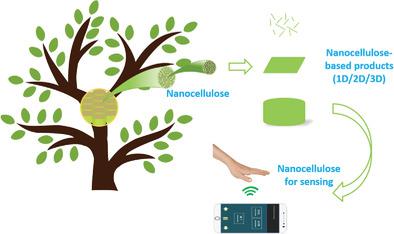Our official English website, www.x-mol.net, welcomes your feedback! (Note: you will need to create a separate account there.)
Ultrasensitive Physical, Bio, and Chemical Sensors Derived from 1-, 2-, and 3-D Nanocellulosic Materials.
Small ( IF 13.3 ) Pub Date : 2020-02-12 , DOI: 10.1002/smll.201906567 Lei Dai 1, 2 , Yan Wang 1 , Xuejun Zou 3 , Zhirong Chen 2 , Hong Liu 4, 5 , Yonghao Ni 6
Small ( IF 13.3 ) Pub Date : 2020-02-12 , DOI: 10.1002/smll.201906567 Lei Dai 1, 2 , Yan Wang 1 , Xuejun Zou 3 , Zhirong Chen 2 , Hong Liu 4, 5 , Yonghao Ni 6
Affiliation

|
Sensors are of increasing interest since they can be applied to daily life in different areas from various industrial sectors. As a natural nanomaterial, nanocellulose plays a vital role in the development of novel sensors, particularly in the context of constructing multidimensional architectures. This review summarizes the utilization of nanocellulose including cellulose nanofibers, cellulose nanocrystals, and bacterial cellulose for sensor design, mainly focusing on the influence of nanocellulose on the sensing performance of these sensors. Special attention is paid to nanocellulose in different forms (1D, 2D, and 3D) to highlight the impact of nanocellulose constructed structures. The aim is to provide a critical review on the most recent progress (especially after 2017) related to nanocellulose-containing sensors, since there are significantly increasing research activities in this area. Moreover, the outlook for the development of nanocellulose-containing sensors is also provided at the end of this work.
中文翻译:

源自1-D,2-D和3-D纳米纤维素材料的超灵敏物理,生物和化学传感器。
传感器越来越受到关注,因为它们可以应用于来自各个工业领域的不同领域中的日常生活。作为天然的纳米材料,纳米纤维素在新型传感器的开发中起着至关重要的作用,特别是在构建多维体系结构的背景下。这篇综述总结了包括纤维素纳米纤维,纤维素纳米晶体和细菌纤维素在内的纳米纤维素在传感器设计中的应用,主要集中在纳米纤维素对这些传感器的传感性能的影响上。要特别注意各种形式(1D,2D和3D)的纳米纤维素,以突出纳米纤维素构建结构的影响。目的是对与含纳米纤维素的传感器相关的最新进展(尤其是2017年之后)进行严格审查,因为该领域的研究活动显着增加。此外,在这项工作的最后还提供了含纳米纤维素传感器的开发前景。
更新日期:2020-04-03
中文翻译:

源自1-D,2-D和3-D纳米纤维素材料的超灵敏物理,生物和化学传感器。
传感器越来越受到关注,因为它们可以应用于来自各个工业领域的不同领域中的日常生活。作为天然的纳米材料,纳米纤维素在新型传感器的开发中起着至关重要的作用,特别是在构建多维体系结构的背景下。这篇综述总结了包括纤维素纳米纤维,纤维素纳米晶体和细菌纤维素在内的纳米纤维素在传感器设计中的应用,主要集中在纳米纤维素对这些传感器的传感性能的影响上。要特别注意各种形式(1D,2D和3D)的纳米纤维素,以突出纳米纤维素构建结构的影响。目的是对与含纳米纤维素的传感器相关的最新进展(尤其是2017年之后)进行严格审查,因为该领域的研究活动显着增加。此外,在这项工作的最后还提供了含纳米纤维素传感器的开发前景。



























 京公网安备 11010802027423号
京公网安备 11010802027423号